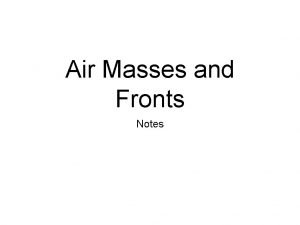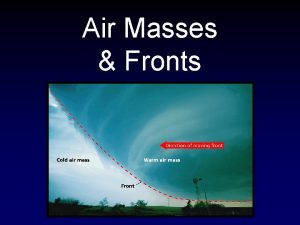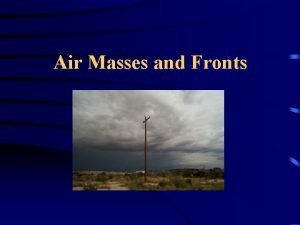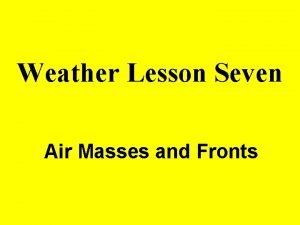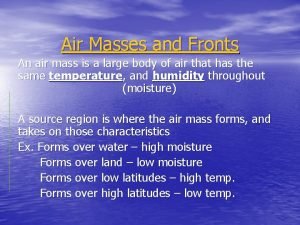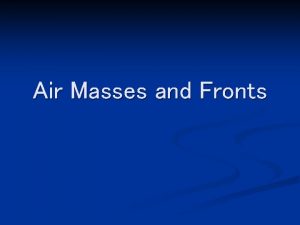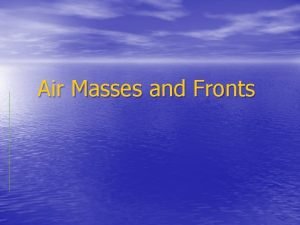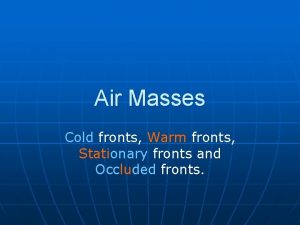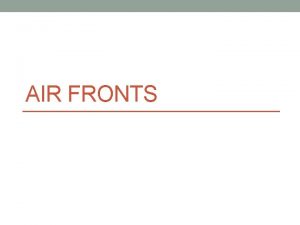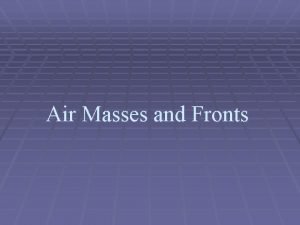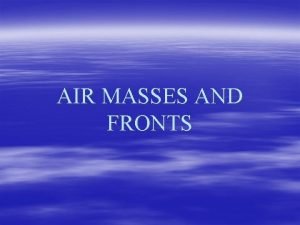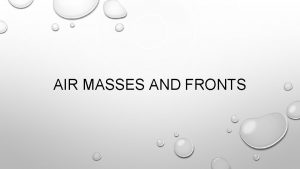Air Masses and Fronts Weather How Do Air











- Slides: 11

Air Masses and Fronts Weather

How Do Air Masses Affect Weather? • Weather maps show that cities across a large region share the same weather and they also show the weather in different areas differs. • A large region of the atmosphere where the air has similar properties throughout is called an air mass. • An air mass gets its properties from the region where it forms.

Air Masses • Air masses are named for the region they come from. • Example, Air over the Gulf of Mexico is above very warm water. The water warms the air, and evaporation from the Gulf adds water vapor. The air becomes warm and moist.

Air Masses • • Maritime polar (m. P) – cool, moist air Continental polar (c. P) – cold, dry air Maritime tropical (m. T) – warm, moist air Continental tropical (c. T) – hot, dry air


• Once an air mass is formed, it is moved by global winds. In the United States, global winds tend to move air masses from west to east. • Air masses with different conditions can “meet. ” That is, one runs into another. • What happens when air masses with different temperatures meet? They don’t mix together. Instead, a narrow boundary forms between them. This boundary is called a front.

• The boundary marks the leading edge, or front, of an air mass that is moving into an area where another air mass is moving out. Weather changes rapidly at fronts. That’s because you pass from one kind of air mass into another. Fronts often cause rainy, unsettled weather.

A Weather Front

How Do Fronts Affect Weather? Cold Front: In a cold front, cold air moves in under warm air mass. Cold fronts bring brief, heavy storms. There may be thunderstorms and strong winds. After the storm the skies are usually clearer, and the weather is usually cooler and drier.

Warm Front: In a warm front, warm air moves in over a cold air mass. Warm fronts often bring light, steady rain or snow. The precipitation may last for days. Winds are usually light. Warm fronts may also bring fog—stratus clouds that form near the ground. Afterward the weather is usually warmer and more humid.

 What are middle-latitude cyclones?
What are middle-latitude cyclones? Low pressure air mass
Low pressure air mass Air masses and fronts
Air masses and fronts Air mass source regions
Air mass source regions Two cold air masses converge on a warm air mass
Two cold air masses converge on a warm air mass Maritime polar
Maritime polar Air masses & frontswhat is an air mass?
Air masses & frontswhat is an air mass? Maritime tropical air mass symbol
Maritime tropical air mass symbol Polar air masses have low air pressure true or false
Polar air masses have low air pressure true or false Air masses & frontswhat is an air mass?
Air masses & frontswhat is an air mass? Air masses & frontswhat is an air mass?
Air masses & frontswhat is an air mass? Air masses & frontswhat is an air mass?
Air masses & frontswhat is an air mass?

